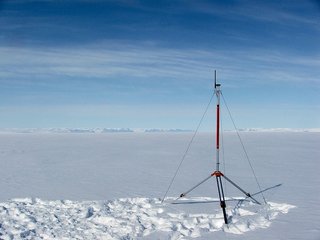Megacanyon hidden below Greenland’s ice sheet
British scientists have discovered a long and deep megacanyon hidden under ice up to 2 km thick. It is at least 750km long and up to 800m deep in places, comparable in size with the Grand Canyon in North America.
“Unexpectedly finding an unknown subglacial valley of this magnitude illustrates why Greenland is such an exciting place to do research” said Peter Langen, from the Danish Climate Centre at DMI.
The canyon is believed to have been formed by a river that flowed through Greenland well before the ice sheet formed several million years ago, making it an ancient as well as a large feature. The map (figure 1) shows that it leads from central Greenland, close to the present-day Summit of the ice sheet and steadily meanders to the fjord on the north coast which today contains the large Petermann outlet glacier. Petermann glacier has a 70km long floating ice tongue that periodically calves very large ice islands, most recently in July 2012 with a previous one in 2010. The newly discovered grand canyon of Greenland helps to explain some of the curious features found on these icebergs, including deeply incised channels on the underside of the ice shelf, thought originally to have been caused by ocean melting, but now believed to a result of meltwater draining from the interior of the ice sheet.
“The subglacial valley may also perform a valuable function in helping to stabilize the ice sheet as it probably acts as a fast pathway to drain melt water formed at the bed of the ice sheet away to the ocean. This means that large melt reservoirs cannot form at the bed which would otherwise contribute to faster ice flow. This also helps to explain for example, why subglacial lakes rarely occur in Greenland unlike in Antarctica”, added Ruth Mottram a glaciologist at the Danish Climate Centre at DMI.
The canyon was uncovered by scientists from the University of Bristol who were working on Greenland with the EU’s ice2sea project of which DMI is also a participant. The scientists combined radar data gathered over many years by, among many others DTU researchers, together with new data from NASA’s Icebridge project to make a new map of the bed of the ice sheet at a very high resolution.
“In the ice2sea project we have used our existing models to produce projections of ice sheet change in Greenland and the associated changes in global sea level. New data about for example large drainage channels like this mega-canyon must be included in future so that modeling work can be improved further.
You can follow the daily snow fall, snow melt and calving of icebergs from Greenland here on Polar Portal.
Ruth Mottram, rum@dmi.dk
© DMI, September 6, 2013







